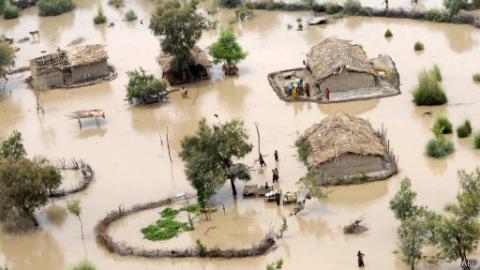Major Climate Report Describes a Changing World
The main finding, Field told reporters, is that “we’re starting to see adaptation happening.” Actions range from ramped-up planning efforts in dozens of U.S. cities and states to European adaptation investments that are adding up to billions of euros. But, Field said, “it’s early days.” And funding appears to be insufficient: “Limited evidence indicates a gap between global adaptation needs and the funds available for adaptation,” the report notes.
Field told reporters that focusing on the often frightening impacts of climate change "can be a downer." But he acknowledged that the world has a long way to go in terms of adaptation and that the assessment found few current or projected positive impacts from climate change. (The few pluses the report mentions include "modest reductions in cold-related mortality and morbidity in some areas.")
Early reaction to the report fell along predictable lines, with those who reject climate change science dismissing it as alarmist, and those convinced that climate change is real welcoming it as a clarion call for action. “This comprehensive report lays out very clearly the evidence that climate change is already having many impacts across the world,” said economist Nicholas Stern of the London School of Economics and Political Science, who warned of climate change’s dangers as a senior official in past U.K. governments, in a prepared statement. "The report warns that, during this century, climate change will increase the risk of human populations being displaced to escape shifts in extreme weather, such as floods and droughts, as well as relatively slow-onset impacts, such as desertification and sea level rise."
Some researchers welcomed the report’s broad scope, which pulled together both physical and social science. "IPCC used to be an institution dominated by physical scientists. Now you don't see that pure domination, at least in Working Group II, anymore," social scientist Susanne Moser, an independent adaptation expert in Santa Cruz, California, told ScienceInsider. Bringing in social scientists to analyze the socioeconomic challenges of climate enriches the analysis on risk, she says. "You get at the interactions of stressors, as opposed to purely 'Here's what the physical science does, and that's the risk we face.' Well, not quite so."
Weighing in at more than 2000 pages, the tome encompasses the work of 309 authors and reviewers, aided by more than 400 so-called contributing authors. The scientists needed all the help they could get: The number of scientific publications assessing climate impacts, vulnerability, or adaptation "more than doubled" between 2005 and 2010. More than 1700 reviewers from the government, academic, or nonprofit sector offered comments on the draft report, which assessed literature published up until last summer.
Eli Kintisch

